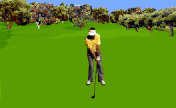By Jack Moorehouse
If you usually slice off the tee, you’re costing yourself strokes. Slicing lands you in instant trouble, leaving you with bad lies and tough shots. More importantly, slicing boosts your golf handicap and increases pressure on your short game. Most slicers know this. That’s why they’re always looking for a cure. Some find it. Others don’t. Those who don’t find a solution often get frustrated.
But you don’t have to get frustrated with your slice. You can eliminate it once and for all by following a simple, four-step process. It tells you why you slice and provides golf tips that can help correct it. In the end you get a slice-free swing that has you thinking—and acting—like a new player. Eliminating your slice helps chop strokes off your golf handicap and eliminates frustration. Below is the four-step process:
Step 1: Examine Your Divots
Slicers create three types of divots. Each reveals the mechanical problems behind their slice.
Divots that move extremely left of the target line result from swings combining an open clubface and an incorrect swing path.
Divots that move somewhat left of target and then curve back across the target line result from a faulty swing path traveling outside in and across the ball.
Divots that move relatively in line with the swing path but drift slightly left result from and open clubface at impact.
Step 2: Determine Your Downswing Type
Downswings are driven by either a pulling (rotary) or a pushing (lever) motion. A rotary-driven swing uses the hip and trunk rotation as the primary force moving the club. With this type of swing, the golfer turns his or her body counterclockwise, with the club being dragged through impact. A lever-driven swing is one in which the right hand and forearm are the primary force behind the downswing. With this type of swing, the shoulder and chest rotation are delayed as the right hand and forearm power the club down into impact.

Step 3: Match Your Grip
It’s critical that your grip matches your downswing type. If you’re a rotary swinger, you need a stronger grip than a leverage swinger. A stronger grip counters the open impact position by keeping the right hand and elbow bent and tucked into the body, which in turn lowers the right shoulder and keeps the clubhead on the correct path.
If you’re a lever swinger, you want a more conventional grip or even a bit of a weaker grip. For a lever swinger, a grip that’s too strong results in a closed clubface at impact, producing hooks. To make sure your grip works with your swing type, focus on developing a setup position that’s correct and use your impact position to check on your grip—when your wrists unhinge at impact, the clubface should be square.
Step 4: Find The Slot
It’s critical you get the club properly slotted.? It’s also critical you match your transition to your swing type. If you’re a rotary swinger, the most important things to focus on when making the transition into the slot are letting the arms be relatively passive so they can swing freely and maintaining a slightly closed clubface position. At the top the rotary swinger’s position is somewhat flatter than the lever swinger’s and the left wrist is slightly bowed. Both are musts.
If you’re a lever swinger, the most important things to focus on when making the transition is shifting your weight onto the left leg, shifting the left shoulder left with no pulling of the left arm, and keeping the right wrists bent. At the top, the most important things are keeping the clubface square and the right hand and wrist bent to maintain width and keep the club on path.
Slicing is the game’s most common swing fault. It’s also among its deadliest. If you slice consistently off the tee, you’re often find yourself in instant trouble. This costs you strokes and boosts your golf handicap. To eliminate your slice, follow the four-step process described above. It will help you to hit them long and straight. Hitting them long and straight like they teach you in golf lessons boosts confidence and saves frustration.
This entry was posted on Monday, August 9th, 2010 at 2:17 pm and is filed under Golf Articles. You can follow any responses to this entry through the RSS 2.0 feed. You can leave a response, or trackback from your own site.




No comments:
Post a Comment